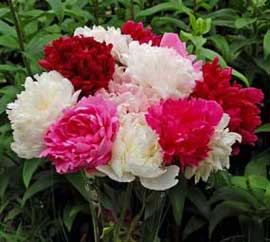Here’s a wealth of information about PEONIES from our email Gazette and past catalogs, starting with the most recently published. For other topics, please see our main Newsletter Archives page.
To subscribe to our FREE email newsletter, click here.
2 Experts, 3 Fall-Planted Treasures

If you don’t have an expert head gardener or landscape architect living next door to help you with your bulb-planting choices this fall, here are three recommendations we’ve gathered for you. (No need to thank us.)
Galanthus elwesii – Writing in the February 2019 issue of Gardens Illustrated, British head gardener Tom Brown calls Elwes snowdrop “a superb form of this winter favorite,” adding “I particularly enjoy growing this species, not only for the large, white flowers – which can often be twice the size of our much-loved common snowdrop – but also because of the opulent, glaucous foliage.” (The RHS is also a big fan, having given it the prestigious Award of Garden Merit.)
‘Thalia’ – In his list of “100 Most Beautiful and Useful Plants,” in that same issue of Gardens Illustrated, Swedish landscape architect Ulf Nordfjell includes this popular old daffodil. He describes it as “a late-flowering cultivar that produces many pure white flowers,” and says it “provides a delicate counterpoint to early shoots of perennials such as astilbes and epimediums.”
‘Duchesse de Nemours’ – This grand old peony is another of Nordfjell’s “100 Most Beautiful and Useful Plants.” It’s “an old-fashioned, scented, double, creamy-white flowering peony, and a real beauty,” he writes, and “my favorite, especially among carpets of violets.” (And even though it’s over 150 years old, the ‘Duchesse’ is an RHS Award of Garden Merit winner, too.) (August 2019)
Book of the Month: Peonies – Beautiful Varieties for Home and Garden
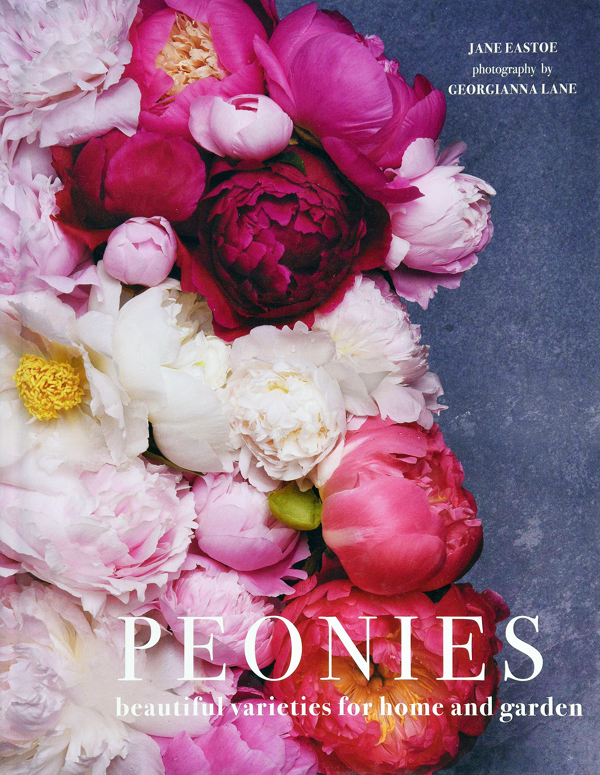
If you’re not quite ready for peony season to be over – or if you’re already telling yourself that this fall you really are going to add a couple of extra-special ones to your garden – here’s a book you may find both comforting and inspiring.
As I wrote in March about its companion volume, Dahlias, it’s “a gorgeous book, filled to overflowing with spectacular, full page images that are sure to get a gardener’s heart pounding.” These include close-ups of each of the 53 featured varieties as well as shots of peonies blooming en masse in the growers’ fields or artfully combined into exquisite bouquets. Photographer Georgianna Lane is a master at capturing the inner glow and subtle shadings of peonies which makes them come alive on the page.
Although Jane Eastoe’s text is full of historical tidbits, mostly about the diverse breeders who created these well-loved flowers, there are puzzling errors. For example, Eastoe says that ‘Miss America’ is “one of the easiest varieties to propagate by seed,” even though seed-grown peonies virtually never come true from seed, and she describes ‘Karl Rosenfield’ as a peony that should spring to mind when someone says “think pink,” even though ‘Karl Rosenfield’ is usually described as deep red.
Ah, but those magnificent photographs! Although Peonies isn’t a perfect book, I’d say it’s well worth the $16.82 Amazon charges for it. (June 2019)
The Princess and the Peony
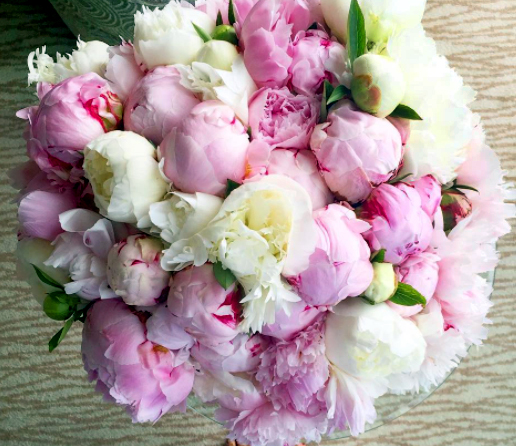
If you’re still wondering what to send the Duke and Duchess of Sussex to celebrate the birth of baby Archie Harrison Mountbatten-Windsor, you might consider a big bouquet of peonies.
In case you missed it, peonies were featured prominently in the royal wedding last May. Meghan Markle has been a flower-lover since childhood – so much so that her mother’s nickname for her was Flower – and according to the London Daily Mail, “peonies are Markle’s favorite flower.”
“After she started dating Prince Harry,” the Mail reported, “she posted Instagram photos of a stunning bouquet of pink and white peonies [pictured here], captioning it: ‘Swooning over these. #peonies #spoiledrotten’.” Earlier she’d also posted “I bought these peonies for myself yesterday because they make me so endlessly happy. Do something sweet for yourself today too. #treatyourself #simplepleasures #favoriteflowers.”
Will peonies make you “endlessly happy”? We can’t guarantee that, but they are easy to grow, incredibly long-lived, and gorgeous. So why not “do something sweet for yourself today” and order a couple for planting this fall! (May, 2019)
For Better Peonies, Cut and Destroy Foliage Now
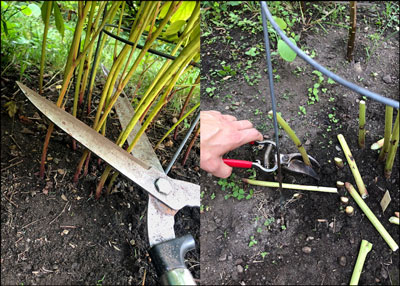
Peonies are rarely troubled by pests or diseases, but here’s an easy, poison-free way to make sure yours stay that way. We do it every fall.
1. Don’t wait. Cut them down early enough that the leaves are still green. If you wait until they’re dry and brittle, they’ll be much harder to clean up – and disease organisms can over-winter on any scrap that’s left behind.
2. Start with hedge-clippers so you can cut many stems at once. Chop them off a few inches above the ground, and pile the foliage to the side.
3. Follow up with pruning shears to cut the remaining few inches off as close to the ground as possible – being careful not to injure the pink buds of next year’s stems which are at or just below the soil surface.
4. Bag all leaves and stems in plastic trash bags. DO NOT COMPOST. Your goal is to leave virtually nothing behind that disease organisms can over-winter in.
5. Sterilize your tools by dipping or rubbing them with bleach or alcohol before going on to the next peony.
That doesn’t sound so bad, does it? And remember, healthy peonies bloom more! (October 2018)
Learning from You: Are Peonies Really Rabbit-Proof?

Until a few years ago I don’t think I’d ever seen a rabbit in our garden here in the center of Ann Arbor, but now they’re everywhere. They devoured my glory-of-the-snow this spring, and my neighbor says they’re the reason why so few of our self-sowing larkspur bloomed this summer.
Peonies, though, are not one of their favorite foods, according to UK nurserywoman Claire Austin who has grown hundreds of them since the 1980s when her father, the famed rose breeder David Austin, gave them up for roses.
“Did you know that peonies are rabbit-proof?” she writes in the May 2018 issue of Country Living. “If you have rabbits that like nothing better than to nibble from your borders, get planting peonies! Rabbits do not like the taste . . . and won’t be tempted to snack on their roots, stems or blooms.”
But Claire gardens in Wales, and we’re wondering if what she says is also true for American rabbits. A few stalks of my peonies were chewed on for the first time this year, and I blamed the rabbits. It was minor damage, but I’m still wondering – do the rabbits in your garden leave your peonies alone? (August 2018)
Art from the Garden: Manet’s Peonies
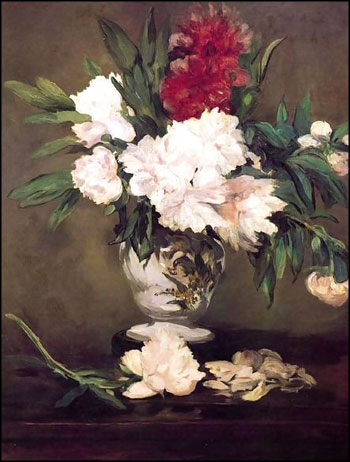
As the buds on our peonies here in Ann Arbor swell with promise, I’ve been thinking about the great French artist Edouard Manet, whose ground-breaking works helped to launch Impressionism and changed art as we know it forever.
In 1864-65, just after he exhibited his best-known work, the scandalous Luncheon on the Grass, Manet made several paintings of peonies, including Peonies in a Vase on a Stand, pictured here. According to a 1983 exhibition catalog published by the Galeries Nationales du Grand Palais in Paris, these works “painted at the peak of his artistic vitality are allegories of vanity . . . [and] the transience of beauty,” as were many of the magnificent Dutch flower paintings of the 1600s.
“Van Gogh was much struck by this painting,” the catalog continues, “and mentions it at a time when he was himself working on a flower series: ‘Do you remember that one day we saw a very extraordinary Manet at the Hôtel Drouot, some huge pink peonies with their green leaves against a light background? As free in the open air and as much a flower as anything could be, and yet painted in a perfectly solid impasto.’”
Unfortunately, although Van Gogh described the peonies as pink, they look white today because the pigments Manet used have deteriorated over time – a problem which has also afflicted several of Van Gogh’s works including Vase with Pink Roses, now at the National Gallery in Washington, DC.
At the time Manet painted this image, peonies were held “in high esteem, recently introduced into Europe and still considered an item of luxury,” which would have made the painting especially appealing to Manet’s “elegant clientele.” More importantly, though, “Manet simply liked peonies. He grew them in his garden at Gennevilliers, and their exuberance . . . was in perfect harmony with his generous and sensuous brushwork.”
See more of Manet’s peony paintings at Google Images – and then garden like the master himself by ordering your own peonies now for delivery this fall! (May 2018)
Gardening at the Sink with Peony-Scented Dish Soap

Have you ever been excited about dish soap? As head dish-washer at our house, that’s exactly how I felt when I saw peony-scented dish soap at the supermarket recently.
With a vintage vibe and environmentally-friendly ingredients, Mrs. Meyer’s Clean Day household products have a gained a national following. The company’s founder named the company for her mother, saying she was inspired to make cleaning products that “smell nice, like my mom’s garden.”
Scents include basil, lavender, and honeysuckle, along with more unusual “limited edition” fragrances such as rhubarb, sunflower, and – the one I plan to try next – radish.
So does the peony-scented soap really smell like peonies? Not to my nose, but it does smell wonderfully flowery and fresh, and I like it a lot. See their full line-up – from air freshener to hand lotion – and find a source near you at MrsMeyers.com. (April 2018)
A Great New Guide to Peonies
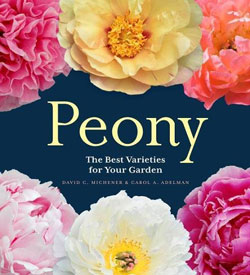
Peony: The Best Varieties for Your Garden – This book is so new that Amazon isn’t even shipping it until later this month, but I got a copy Monday and couldn’t wait to tell you about it.
It’s definitely “a stunner,” as co-author David Michener of the University of Michigan Peony Garden told me, with page after page of glorious photos, many by co-author Carol Adelman of Oregon’s Adelman Peony Gardens. After chapters on peony history and origins, peony types, gardening with peonies, and peonies as cut flowers, most of the book is devoted to mouth-watering close-ups and short descriptions of nearly 200 peonies.
Although I wish there were more heirlooms, David and Carol have put together a line-up that’s impressively diverse. Most are herbaceous peonies, but there are plenty of intersectional and tree peonies, too, all dating from 1824 to 2015, and the incredible range of colors and forms is sure to have you ooo-ing and ahhh-ing. The book’s price is impressive, too – just $19 at Amazon. So what are you waiting for? (Dec. 2017)
Protect Peonies and Iris with an Easy Fall Clean-Up
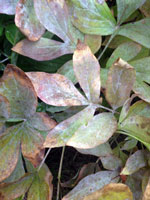
For healthier plants and even more flowers, give your peonies and iris a simple fall clean-up.
PEONIES – Although peonies are generally care-free, they can be afflicted by powdery mildew (pictured here) and other fungal diseases. To prevent spores from overwintering, cut peony stems as close to the ground as possible, carefully bagging everything as you go, and dispose in the trash instead of composting. For best results, do this earlier rather than later, before the leaves dry up.
IRIS – Fall is also the best time to control iris borers. Borers hatch in spring from eggs laid in fall on iris leaves and anything similar that’s close by. To destroy them, simply wait until after a good hard frost kills the adult moths and then (a) cut back all leaves to a couple of inches and (b) remove, bag, and trash – don’t compost – the clippings and any debris or mulch that’s near the plants.
Simple, right? And your plants will reward you! (Sept. 2017)
Peonies and “Pumpkin Spice Latte Gardening”

Pumpkin Spice Latte has returned, and coffee drinkers everywhere are rejoicing.
So why isn’t this wildly popular drink offered year-round, asks Joseph Tychonievich in the current issue of Michigan Gardening. Because then, he says, “we’d drink it, grow tired of it, move on, and forget about it. The fact that this special drink only comes around once a year makes it special.”
And we gardeners can learn from this, Joseph says. “Often in the garden we gravitate to things that bloom or look good for as long as possible,” but “gardens aren’t some math problem. . . . The really important harvest is not flowers or even food, but joy. So maybe it is time to step back a little from all of the long-blooming, forever-performing plants and embrace flowers that . . . instead inspire us with wild joy, anticipation, and glee.”
His top suggestion, we’re happy to say, is peonies – and we’re offering more than ever this fall! Although they don’t bloom forever, “for a few glorious weeks in late May or early June, they’ll positively cover themselves with huge, extravagant, powerfully fragrant flowers.”
“You’ll look forward to that . . . all year long. As the buds swell, you’ll check them each day. When they finally open, you’ll sit next to them drinking in the rich scent. You’ll cut armloads of them. . . . You may even throw a party in their honor.”
Of course “it doesn’t have to be peonies,” Joseph adds. “Find a plant that you truly love, that really thrives and performs in your garden, ignore the fact that it only blooms for a couple weeks in a year, and then plant them by the dozens and revel deeply in the sheer magic of their performance.
“Don’t let anyone tell you they aren’t practical. Gardening is about passion, not practicality. . . . Remember the lesson of the Pumpkin Spice Latte and keep some magic and anticipation in your garden.” (Sept. 2017)
“Magnificent, Almost Immortal” Peonies

If “a display of great big gorgeous flowers is what you are after,” writes Eleanor Perenyi in her timeless classic Green Thoughts (1981), “herbaceous peonies are my choice.”
Why? Unlike tree peonies, “herbaceous peonies stand straight and tall, don’t hide their heads, and are magnificent for cutting. They aren’t temperamental, deciding, for inscrutable reasons, to withhold their bloom for a year. They are almost immortal, even when hopelessly neglected in the backyards of old farms.” And although “all peonies suffer when a heavy rain hits them,” all they need is “a good shake to revive.”
As for fragrance, “peony scents vary greatly,” Perenyi notes, “from one so like a rose I couldn’t, in the dark, tell the difference, to an acrid sweetness not unlike the lilac’s. The doubles smell better than the singles and the herbaceous better than the tree peonies – to me.”
We’re offering more peonies than ever this fall, including four for the first time and four web-only. The only downside to this abundance is that ‘Shawnee Chief’ (pictured) ended up all alone on the second page at our website. Don’t miss it – it’s superb. (Aug. 2017)
Peony Vodka: Intoxicating Beauty

Heirloom peonies are rich in beauty, fragrance, and memories – but have you ever tried drinking them?
Now you can, thanks to Three Meadows Spirits, a New York-state micro-distillery. Headquartered in an 18th-century farmhouse, Three Meadows is part of the booming American craft spirits industry. Its unique Peony Vodka is subtly flavored with a blend of nine natural ingredients including “tincture of peony” derived from the roots of an antique row of peonies growing at the farm of founder Leslie Farhangi.
Although herbalists in Europe and China have used peony root for centuries to treat a variety of ills, Three Meadows claims only that its vodka is versatile and delicious.
Learn more in this recent article or visit the Three Meadows website where a big, beautiful peony bud on their homepage opens to full bloom in less than 30 seconds. And if you’d like to try a glass of Peony Vodka yourself – maybe as you sit in the garden on a warm summer evening – you can order it online here. To peonies! (July 2017)
America’s First Peony – and One of Louise Beebe Wilder’s Favorites
The vast majority of the peonies grown today are cultivars of the Asian Paeonia lactiflora, the first of which arrived here from China in the early 1800s causing a sensation.
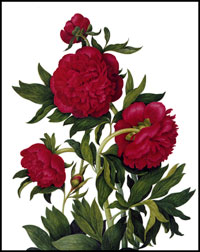
But long before the lactifloras appeared, the colonists were growing a completely different species, the European P. officinalis, which had been revered as a medicinal herb since ancient times. (Officinalis means “of the [apothecary] shops.”)
Since they bloom a week or two earlier than the lactifloras, the officinalis clan came to be called May-flowering peonies. Double red ‘Rubra Plena’ was the most popular form, especially in the 19th century when it decorated the graves of so many Civil War veterans that it was called the Memorial Day peony.
But times change, and as the Civil War faded in the past and hundreds of exciting new lactiflora peonies were introduced, the old officinalis peonies gradually fell out of fashion.
“Today the May-flowering peony is neglected,” wrote the great American garden writer Louise Beebe Wilder in 1927. Yet “in peaceful old gardens that remain unfretted by changing fashions and modern introductions we are apt to find huge bushes of the old May-flowering peony or “piny” as it is called in country neighborhoods. . . .”
Several officinalis peonies grew in the Maryland garden of Wilder’s childhood. “There was the “old crimson” [‘Rubra Plena’],” she wrote, “which is yet one of my favorite peonies and exhibits almost the richest color that I know. There was a full pink sort that we children called the ‘strawberry-ice-cream peony,’ and there was a loose-petalled white one.” When she later bought an old house and garden in New York, Wilder was “happy to find those sweet and wholesome friends of my childhood growing in the tangled dooryard.”
Ancient, herbal, early-blooming, richly colored, and enduring – why not add P. officinalis ‘Rubra Plena’ to your dooryard this fall? (July 2016)
Tips for Making Your Peonies in Bouquets Last Longer
Lush and romantic, peonies are fabulous in bouquets. To get the most out of yours, here are some tips from Dr. Patricia Holloway of the University of Alaska, as quoted by Debra Prinzing in her 2013 Slow Flowers:
“‘Cut peonies during the coolest part of the day. Cut once you see the true color of the flower with one or two petals separating at the top [the “soft marshmallow” stage] – or any time after that. Then the flower will continue to open in your arrangement.’ If you cut prior to this stage the buds either will not open or they will be stunted. Fully-opened blooms can also be harvested, but their vase life is shorter. . . .
“Dr. Holloway also offers this commercial growers’ tip; ‘Once cut, your flowers should be chilled in the refrigerator for at least 24 hours and up to one week before putting them into a vase. That chilling very definitely extends vase life.’ Wrap the peonies in paper towels and lay them flat in the crisper drawer, away from the refrigerator’s other contents.”
We’ll also remind you that for future growth and bloom it’s best to leave as much foliage as possible on the plant. This is especially important during the first two years after planting, and in fact many experts recommend that you cut NO flowers the first year. We know how hard that can be, but your patience will be rewarded. (May 2016)
Find Peonies in Bloom Near You with This Online Guide
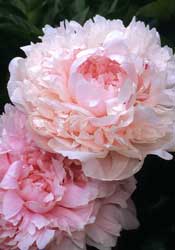
Just in time for peony season, the website of the American Peony Society has added a finder’s guide to 77 peony-rich public gardens in 30 states from Maine to California.
The gardens range from well-known sites to fascinating smaller gardens such as Sisson’s Peony Gardens in Wisconsin and the Shacksboro Schoolhouse Museum in New York with its collection of nearly 200 heritage varieties. Some sites make it surprisingly hard to find information about their peonies, but if a search for “peony” or “paeonia” returns no results, you can always call the garden and talk to a human being.
The guide also lists 28 peony gardens in other countries, including many in China where peonies have been revered for centuries. Altogether there’s a total of 105 gardens waiting for you to explore at americanpeonysociety.org/links/peony-gardens.
(And if you’re really in the mood for peonies, check out the four you can order now for fall planting at oldhousegardens.com/Peonies.) (April 2016)
3 Ways to Support Your Big, Beautiful Peonies
Au Naturel – Although we always look for strong stems when we’re evaluating peonies for our catalog, even the strongest stems will bow when their gloriously double flowers are drenched by rain. If you gently shake the water out immediately afterwards, most of the time they’ll stand back up, so most gardeners simply cross their fingers and grow their peonies without support, au naturel.
Cheap and Easy – Although garden centers offer all sorts of wire-ring and linking-stake supports for peonies, most of these are surprisingly pricey. A less expensive option (and what we usually do here at OHG) is to cut a wire-ring tomato tower in half just above one of the rings, so you have two shorter towers. Use the narrower one for newly-planted peonies or smaller perennials, and the wider one for mature peonies. Set it over the plant, pushing the legs securely into the soil. The earlier you do this the better, because once the plant has leafed out you’ll need a helper – or twine – to contain the foliage while you slip the support over it. Leave some stems and foliage outside the support for a more relaxed, natural-looking plant and to hide the wire which is virtually invisible anyway, especially once it rusts.
The Hildene Star – There’s a better, more historic way they use to support the 175 peonies at Hildene, the summer home of President Lincoln’s son in Manchester, Vermont. Basically you insert five short stakes in a circle at the outer edges of the plant, weave twine back and forth to create a star, and then finish by circling the stakes with twine. Hildene’s Andrea Luchini offers complete instructions. Although I can’t imagine doing it for 175 peonies, for a few it’s actually kind of fun. (May 2015)
Mildew on Your Peonies? Act NOW to Control It
Although peonies are rarely bothered by pests or diseases, powdery mildew has become a problem in some areas. We first wrote about it in 2012, and expert Don Hollingsworth recently offered his perspective in the APS Bulletin. Don has been growing peonies since the 1930s but he says “it was not until 2014 that I noticed the striking sight of white mildew” on a few of the hundreds of peonies at his farm in Missouri. He searched the web but found no explanation as to “why powdery mildew is only now taking hold on peonies, while it has long been known to affect other commonly grown ornamental plants.”
To control it, Don says “the first line of defense is to clean up and destroy all infected plant parts at season’s end” to prevent spores from overwintering — and earlier is better than later. Instead of waiting until late fall, cut infected plants to the ground and carefully bag and remove all foliage “before the leaves dry up, which is best accomplished well before frost.” Don also offers a recipe for a preventative spray by the Massachusetts Master Gardeners: “In a quart of water add a few drops of liquid dish soap and a teaspoon of baking soda.” That’s similar to the spray we recommended two years ago: Mix 1 tablespoon of baking soda and 1 tablespoon of horticultural oil (or vegetable oil) in a gallon of water. Spray weekly throughout the spring, using a new mix every time and avoiding overuse to prevent a build-up of salts in the soil. (late Sept. 2014)
Fragrance in Peonies — Including the Fern-Leaf?
“Peonies play a significant part in the omnium gatherum of June odors,” Louise Beebe Wilder wrote in her 1932 classic The Fragrant Path. “Peonies do not, of course, all smell alike, and many of them have practically no smell at all. Few of the single kinds are markedly sweet-scented, nor are [most of the red ones]. The purest and most delicious quality of scent is found in the various pale pink varieties [such as ‘Mrs. Franklin D. Roosevelt’ and deeper-pink ‘Edulis Superba’] and in the white and blush-colored kinds [such as ‘Elsa Sass’].
Beebe also claimed that Paeonia tenuifolia, the fern-leaf peony is fragrant. This surprised me because I’ve grown it for years and never noticed that — so if you’ve sniffed it, please let us know what you found. “Several Paeonia species have fragrant flowers,” she wrote, “among them the little red flowered P. tenuifolia, from the Ukraine called the Adonis peony because of the similarity of its feathery foliage to that of the Adonis. It is a charming little species, suitable for and in harmony with the rock garden as well as for border life. It is the first of its race to bloom and after the flowering is past and seed has matured, the plant dies to the ground and is seen no more until the following spring. So mark well its dwelling that you may not injure it in digging about.” (Sept. 2014)
Donor Gives $500,000 to Nurture Heirloom Peonies
The historic Nichols Arboretum Peony Garden at the University of Michigan received a huge boost recently when the last surviving grandchild of the original donor gave a half-million dollars to help fund its ongoing restoration. The Peony Garden was established in the 1920s when W.E. Upjohn, founder of the Upjohn pharmaceutical company, gave the university hundreds of peonies from his private collection. “We’re honored that the University has cared for the peony collection for more than 90 years,” Upjohn’s granddaughter Martha G. Parfet said in announcing her gift, “and proud to be part of the effort to preserve the collection for the future.” According to the University, Parfet’s gift “will play a key role in three long-term stewardship goals for the Peony Garden as a model for historic gardens.” Learn more at umich.edu/mbg/happening/peonygift.asp . (Nov. 2013)
Peonies Thrive for Betty in Dallas, Despite Our Warning
When you ship flower bulbs to all 50 states, you learn a lot from your customers. For example, when we warned Betty Brownlee of Dallas that we didn’t recommend the peonies she was ordering for her zone-8a garden, she replied: “Please leave my order as is. I have a spot on the north side of my house that peonies love. I had 70 blooms last year. Thank you.”
Despite her success, most experts will tell you that peonies are always a bit of a crap shoot in zone 8a South (and 8b on the West Coast). If you’re determined to give them a try there, we recommend starting with two that need a little less “chill time” in order to develop buds and bloom: ‘Festiva Maxima’ and ‘Philippe Rivoire’. And good luck! (Oct. 2013)
Nature Boy Digs “Queen of the Garden”
You might think that the guy who wrote The Natural Garden, The Natural Shade Garden, and The Natural Habitat Garden would grow only wildflowers in his home garden, but superstar author and photographer Ken Druse is a big fan of peonies, too. In fact, “if I had to pick one spring-blooming perennial to be called ‘queen of the garden,’” he writes, “it would have to be the peony. I am not talking about a prom queen, here — more like Elizabeth I. These are tough old plants, and age is an appropriate thing to talk about since these plants can live for one hundred years or more.”
Among the peonies Ken grows in his New Jersey garden are fragrant white ‘Duchesse de Nemours’ and fragrant pink ‘Mrs. Franklin D. Roosevelt’ which he calls “one of my favorite flowers.” Ken also enjoys single peonies such as ‘Early Scout’ — click on its thumbnail photo to get a better look at its handsome, cut-leaf foliage — explaining that their “lightweight flowers are not troubled by weather” and remain upright despite wind and rain. We start shipping our big, Iowa-grown peony roots October 1, and the sooner you plant them, the happier they’ll be.
Ken’s “Real Dirt” podcast this week is a replay of our talk last year celebrating our 20th anniversary. If you missed it then, you can listen to it now. (Sept. 2013)
Peonies for Prohibition
Rejoining our catalog this year is the fabulous ‘Duchesse de Nemours’ peony. In the 1920s, peony connoisseur (and UM peony garden donor) William Upjohn wrote that “its fragrance is said to be ‘most intoxicating’” and added wryly “this should make it the most popular peony in dry America.” (June 2013)
Link of the Month: Historic Peony Garden Launches New Website
Our friends at the University of Michigan Peony Garden — the country’s largest collection of historic peonies — are beaming. In February the North American Plant Collections Consortium awarded the Garden “full status accreditation.” On June 1 their efforts to restore, catalog, expand, and bring the Garden online will be showcased at the American Peony Society’s national convention in a presentation titled “How a National Treasure Just Got Better.” And the Garden’s impressive new website is now online at mbgna.umich.edu/peony/. Although the staff is still polishing it and there are big plans for future expansion, it’s already a great resource for anyone who loves peonies. You can search the Garden’s 315 cultivars by color, form, breeder, etc., learn how to divide peonies, explore the peony’s Asian connections, find other peony collections near you, check the Bloom Countdown, and more. Give it a look — and have fun! (May 2013)
Fragrance in the Garden: 10 Easy Ways to Enjoy It More
Much more than a list of fragrant plants, Barbara Pleasant’s online article “Make Scents” offers ten tips for enjoying more fragrance in your garden. We especially liked her tip #4, “Pursue Petal Power,” in which she explains that “flower fragrance can be produced by nectar, stamens, or pistils, but petals are usually the main wellsprings of scent. This is why double peonies such as . . . ‘Festiva Maxima’ often produce more perfume over a longer period of time than single-flowered varieties. Aroma-producing petals often have a waxy or velvety finish that’s caused by the oil in aromatic compounds. When a honeybee moves about on scented petals, oils that rub off on its body are carried back to the hive, which spreads the news to other bees that a plant worthy of repeat visits has been found.” Read it all at the National Home Gardening Club website — and while you’re there check out the free trial membership which includes an issue of their excellent Gardening How-To magazine.
Of course many heirloom bulbs are rich in fragrance, including spring-planted tuberoses. See a complete list of ours by clicking “Fragrant” at our easy Advanced Search page. Then just order, plant, and enjoy! (March 2013)
Ghostly Trend: Mildew on Peonies
I’ve been growing peonies in my home garden for 30 years. They’re typically trouble-free plants, but early this fall, for the first time ever, a couple of them were covered with what looked like powdery mildew — and I soon noticed other ghostly white peonies all over town. So I called Carmen Leskoviansky of the University of Michigan’s world-class peony garden and asked her: what is it, why is it so common this year, and how should I treat it?
It’s just plain old powdery mildew, Carmen assured me, and it’s been a recurrent problem in the UM peonies. Some years it’s worse than others, and Carmen thinks it may be especially bad this year because the summer’s extreme heat and drought stressed the plants, making them more susceptible. Shade and poor air circulation also favor the disease. “We don’t usually treat for it,” Carmen added. “However, as with managing botrytis, I always tell folks to trash the foliage in the fall instead of composting it, since spores can overwinter.” Warmer winters may be allowing more spores to survive, which could be another reason the disease seems to have become more common recently.
The good news is that it’s mostly a cosmetic problem, and by the time it shows up in the fall the plants are ready to go dormant anyway. I cut my infected plants to the ground, carefully cleaned up all the debris, plastic-bagged it, and threw it in the trash (do NOT compost it). In the spring I may follow up with a fungicide spray, possibly this organic one that Kelly, our Farms Manager, recommended: Mix 1 tablespoon of baking soda and 1 tablespoon of horticultural oil (or vegetable oil) in a gallon of water. Spray weekly throughout the spring, using a new mix every time, and avoid overuse to prevent a build-up of salts in the soil. Learn more about controlling mildew here. (Oct. 2012)
3 Recent Blogs about Our Bulbs and a Great New Webzine
I’m a Dunder-Mifflin kind of guy — one who will always love books, magazines, and newspapers printed on actual paper — but gradually I’ve been discovering and enjoying a lot of excellent garden writing on the internet, too. Here are a few recent favorites:
Betsy Ginsburg at GardenersApprentice.com blogs about her quest for “holy grail” plants such as our “Double Yellow” hyacinth in “Hyacinth Discovery” and tells the story of our ‘Frances Willard’ peony and the women behind it in “A Peony’s Tale.”
Gail Eichelberger at ClayandLimestone.com blogs about red spider lilies and the old daffodils she found at her place in Tennessee in “It’s Late Summer and a Gardener’s Thoughts Turn to Fall-Planted Bulbs.”
Michelle Slatalla at Gardenista.com blogs about our daffodils in “5 Quick Fixes: The Rarified Daffodil” (and calls me “blessedly fanatical” — which I’m taking as a compliment).
And last but far from least, Elizabeth Licata of GardenRant.com recently turned me on to Leaf, a terrific online garden magazine. In its autumn issue you’ll find Elizabeth’s article on “Artful Forcing”, a piece about John Shipton, the grower in Wales who we get our true English bluebells from, and even a short article about the growing popularity of artisanal American corn whiskey. (Sept. 2012)
Investing in Beauty: A Timeless Tip from 1916
We stumbled upon this unusual investment tip in the 1916 Manual on the Iris by Nebraska nurseryman and minister Charles S. Harrison:
“Beauty is Wealth. Raise a plenty of it and be rich. No investment can pay better. You build a new house at great expense and it begins to deteriorate from the moment you enter it. In a short time your beautiful furniture becomes second hand.
“Out in your yard ... peonies double every two years, which gives you 50 percent interest on your money. And the radiant iris in ‘garments of woven delight’ gives you ten from one in two years. Beautify your grounds and double the value of your land. It makes a great difference whether your yard is a landscape of beauty or a pasture for pigs or a hospital for disabled machinery.” (August 2012)
Combining Bulbs with Daylilies, Peonies, and Other Perennials
Mass plantings of tulips or daffodils can be thrilling — be they at Keukenhof or your local mall — but at home few of us plant our bulbs like that. In A Patchwork Garden (1990), Sydney Eddison offers some good advice for integrating bulbs into mixed plantings:
“One of the most valuable lessons I learned from studying the Gills’ spring garden was that by combining bulbs with even a few early-flowering perennials you can have a wonderful display without sacrificing too much precious space. Their use of tulips was particularly striking. Planting them in masses of one color had tremendous impact. The tulips bloomed at the same time as a wealth of herbaceous plants . . . [and] later, their ripening foliage . . . was hidden by their perennial partners and by the emerging foliage of later-blooming perennials. . . .”
“ As I didn’t have that much space, I adopted the idea of pairing bulbs and perennials with a . . . much more limited selection of plants. I began planting tall [Single Late] tulips — cream to white only — in the middle and at the back of the border, always behind or in association with a clump of daylilies or a peony, to provide cover later for the bulbs’ dying foliage. In addition to hiding the ripening tulip leaves, the foliage of the perennials provides an attractive filler among the flowering bulbs. The daylily leaves are fresh and green and the immature peony foliage is dark green to deep red.” (August 2012)
“Yard-Warming” Peonies are Still Warming Hearts 72 Years Later
“You should suggest a ‘yard warming’ to your readers,” our good customer Elaine Owsley of Dexter, Michigan, wrote us. “Then each blooming, growing season will remind the recipients of their friends’ good wishes for their happy future.” Perhaps not surprisingly, we’d never heard of a “yard-warming,” but Elaine explained:
“In 1940, my parents moved into the new home they built in Dearborn, and their friends from the Young Marrieds group at church presented them with a ‘yard warming.’
“The group came bearing perennials and a small tree along with two peony plants — one white and one reddish pink. They planted everything they brought, and my father lovingly tended them for all the years he lived in the house. He passed away in 1976.
“When my mother was going to sell the house ten years later, I took the two peony bushes — I had played around them with my dolls all through my childhood — and brought them to my house where they have bloomed every year since. So here I have a present from 72 years ago to cherish and remember my dad and his love of gardening.” (July 2012)
It’s Official: Spring was Hot
“Call it spring’s fever,” wrote Seth Borenstein in a recent Associated Press article that confirmed what many gardeners already suspected. “Federal records show the US just finished its hottest spring on record. March, April, and May in the lower 48 states beat the coldest spring temperature record by a full 2 degrees. The three months averaged 57.1 degrees, more than 5 degrees above average. That’s the most above normal for any US season on record. . . . The National Oceanic and Atmospheric Administration also reported that it was the second warmest May since records began in 1895. May averaged 64.3 degrees, just behind 1934.”
And it wasn’t only spring. “The first five months of 2012 were the hottest start to a year in US weather record history. The 12-month period starting last June is also the hottest on record.” Whew!
It’s hard to predict all of the ways that this extreme weather will affect plants. Our good friend Art Tucker of the University of Delaware, for example, wrote us in surprise: “This spring was one of the driest and hottest on record for Delaware. About 50% of my established PEONIES refused to emerge and those that have emerged have prolific botrytis, which I have only occasionally noticed here and there in the past. Why botrytis now, after the driest spring on record? I thought botrytis was fostered by moist weather???”
Tulips have also been impacted, especially in zone-7 gardens in the East and Southeast where temperatures last winter were more like those of zone 8. Tulips and many other spring-blooming bulbs need a certain number of hours below about 48 degrees F to develop the gibberellic acid that allows their bloom-stems to lengthen and emerge from the soil — which is why gardeners in zone 8 typically pre-chill tulips for 8-12 weeks before planting. Without that, tulips will bloom on very short stems or even attempt to open their flowers underground.
Gardeners should expect to see long-term effects, too. In many areas, for example, the warm, dry spring pushed bulbs into dormancy earlier than usual, giving the plants less time to photosynthesize and bulk up — which could mean diminished bloom next spring. So stay tuned, and keep your green thumbs crossed. (June 2012)
Save the Peonies! Rescuing the Treasures of a Century-Old Nursery
When I first started collecting heirloom plants in the 1970s, I was elated to discover a small, family-owned nursery in Iowa with an enormous list of peonies. Founded in 1887, Sherman Nursery was especially rich in peonies from the nineteenth century, many of which were no longer available anywhere else. Unfortunately they were wholesale-only and wouldn’t sell to me then, but soon after mailing my first catalog in 1993 I started thinking about someday offering their rare heirlooms.
It took a while, but in 2008 we added peonies to our catalog, and since then all but two of the 18 we’ve offered have come from the Sherman collection. (See them all here and here.) Unfortunately, like many nurseries Sherman’s was hard hit by the economic downturn, and in 2009 it was sold to a much larger Midwestern grower. When I heard the news I was worried about their peonies, because wholesalers typically make their money by selling large volumes of relatively few varieties, but I was busy and . . . before I knew it, instead of the 111 peonies that Sherman’s was growing in 2001, only 56 were still available — and last month we learned that 17 more will be dropped next year.
Although there’s no way Old House Gardens can save all of those peonies, we’re doing what we can. We alerted our friends at the University of Michigan’s historic Peony Garden and they spread the word to some of the country’s leading peony specialists. We also joined forces with the Iowa farmer we get ‘Festiva Maxima’ from, buying the last available roots of several rare peonies from the Sherman ark and turning them over to him to preserve and multiply for us. If all goes well, we’ll see the first fruits of this partnership as early as next year when we hope to offer the fragrant Midwestern classic, ‘Frances Willard’. With your support, there will be more good news. Stay tuned. (Dec. 2011)
Try This at Home: Fresh Peonies Months from Now
In the early 1900s, peonies reigned as one of the country’s leading cut-flowers, in part because they can be stored in bud for months. Yes, months! And it’s easy. Here’s how you can do it yourself, in an article adapted from The American Cottage Gardener magazine by our good friend Nancy McDonald.
“Choose perfect buds of semi-double to double varieties (the heaviest ‘bomb’ types and singles don’t work as well). In the cool of early morning or late evening, cut buds on six-inch stems, just as the petals begin to loosen but are not yet open. Place in gallon-size, zip-lock freezer bags. I put ten to twelve buds per bag, with half the heads facing one way and half the other. Wet a small, new, cellulose sponge or clean dishcloth, wring it out so it’s just barely damp, and put it in the bag. Gently work as much air as possible out of the bag and seal it. Store flat in your refrigerator. You may wish to put the bag in a plastic storage box, so the buds don’t get bruised by people rummaging for that last chicken leg. Make sure everyone in the house knows that they are not to be eaten.
“After the peonies outdoors are just a fragrant memory, start enjoying your stored ones. Cut an inch of stem (underwater is best) and put the peony in water all the way up to the bud. Within half an hour it will begin to open. Arrange in a vase or float in a bowl of water (a charming way to display peonies anytime). Floating ones seem to last longest. Trim stems an inch shorter each day, if needed. Using this simple technique, I have stored buds for as long as three months, and dazzled everyone with bouquets in early September.” (May 2011)
From North to South, Experts Say “Plant This Peony!”
For a peony that never flops and blooms happily from zone 4 to 8 (yes, 8!), experts recommend the 1920s classic, ‘Krinkled White’. Elizabeth Lawrence, patron saint of Southern gardening, called it “the king of the singles.” Tony Avent of Plant Delights Nursery in zone-8a North Carolina says it’s “one of the finest, especially for gardeners in the South,” explaining that it’s “proven to be one of the top low-chill, heat-tolerant, deer-resistant peonies in our trials.” And Joan Severa of zone-4 Wisconsin, Master Gardener and author of Creating a Perennial Garden in the Midwest, says she prefers single peonies because they “hold themselves up and stay fresh-looking better,” adding that “last year I counted 75 blooms on . . . ‘Krinkled White’ which has gorgeous yellow centers and parchment-white petals, charmingly wrinkled.” Why not order one to plant in your garden right now? (Oct. 2010)
Peonies in 1901: “A Well-Gloved Girl Who Can Swim and Ride”
While the magnificence of peony season is still fresh in our mind’s eye, here’s some praise of that enduringly popular flower from Alice Morse Earle’s classic Old Time Gardens, Newly Set Forth. Published in 1901, Earle’s book became enormously popular — a reminder today that we’re not the first gardeners to appreciate heirloom plants.
“The glory of the front yard was the old-fashioned early red ‘piny’, cultivated since the days of Pliny. I hear people speaking of it with contempt as a vulgar flower — ‘flaunting’ is the conventional derogatory adjective — but I glory in its flaunting. The modern varieties, of every tint from white through flesh color, coral, pink, ruby color, salmon, and even yellow, to deep red, are as beautiful as roses. Some are sweet-scented; and they have no thorns, and their foliage is ever perfect, so I am sure the rose is jealous. . . .
“Not the least of the peony’s charms is its exceeding trimness and cleanliness. The plants always look like a well-dressed, well-shod, well-gloved girl of birth, breeding, and of equal good taste and good health; a girl who can swim, and skate, and ride, and play golf. Every inch has a well-set, neat, cared for look which the shape and growth of the plant keeps from seeming artificial or finicky. . . .
“No flower can be set in our garden of more distinct antiquity than the peony; the Greeks believed it to be of divine origin. A green arbor of the fourteenth century in England is described as set around with gillyflower, tansy, gromwell, and ‘pyonys powdered ay betwene’ — just as I like to see peonies set to this day, ‘powdered’ everywhere between all the other flowers of the border.” (June 2010)





